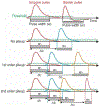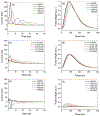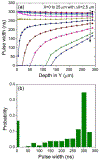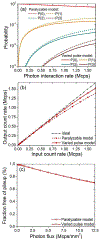Pulse pileup analysis for a double-sided silicon strip detector using variable pulse shapes
- PMID: 31327872
- PMCID: PMC6640861
- DOI: 10.1109/TNS.2019.2917144
Pulse pileup analysis for a double-sided silicon strip detector using variable pulse shapes
Abstract
Due to pulse pileup, photon counting detectors (PCDs) suffer from count loss and energy distortion when operating in high count rate environments. In this paper, we studied the pulse pileup of a double-sided silicon strip detector (DSSSD) to evaluate its potential application in a mammography system. We analyzed the pulse pileup using pulses of varied shapes, where the shape of the pulse depends on the location of photon interaction within the detector. To obtain the shaped pulses, first, transient currents for photons interacting at different locations were simulated using a Technology Computer-Aided Design (TCAD) software. Next, the currents were shaped by a CR-RC2 shaping circuit, calculated using Simulink. After obtaining these pulses, both the different orders of pileup and the energy spectrum were calculated by taking into account the following two factors: 1) spatial distribution of photon interactions within the detector, and 2) time interval distribution between successive photons under a given photon flux. We found that for a DSSSD with thickness of 300 μm, pitch of 25 μm and strip length of 1 cm, under a bias voltage of 50 V, the variable pulse shape model predicts the fraction free of pileup can be > 90 % under a photon flux of 3.75 Mcps/mm2. The double-sided silicon-strip detector is a promising candidate for digital mammography applications.
Keywords: double-sided silicon strip detector; paralyzable detection model; photon counting detector; pulse pileup.
Conflict of interest statement
Disclosure of conflicts of interest M.P. discloses financial interests in Prismatic Sensors AB. All other authors have no relevant conflicts of interest to disclose.
Figures












References
-
- Taguchi K, “Energy-sensitive photon counting detector-based X-ray computed tomography,” Radiol. Phys. and Technol, Vol. 10, no. 1, p. 8–22, 2017. - PubMed
-
- Persson M, Bujia R, Nowik P, Andersson H, Kull L, Andersson J et al., “Upper limits of the photon fluence rate on CT detectors: Case study on a commercial scanner,” Med. Phys, vol. 43, no. 7, pp. 4398–4411, 2016. - PubMed
Grants and funding
LinkOut - more resources
Full Text Sources
